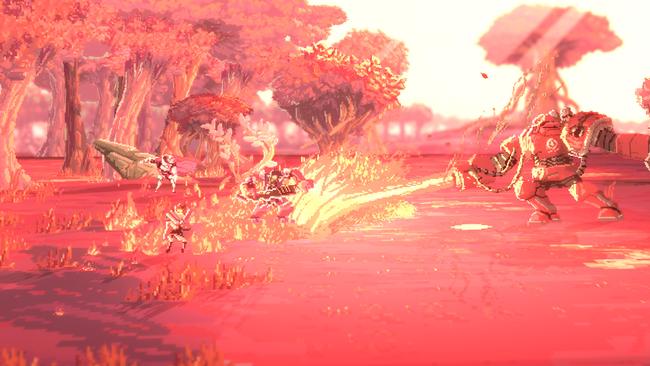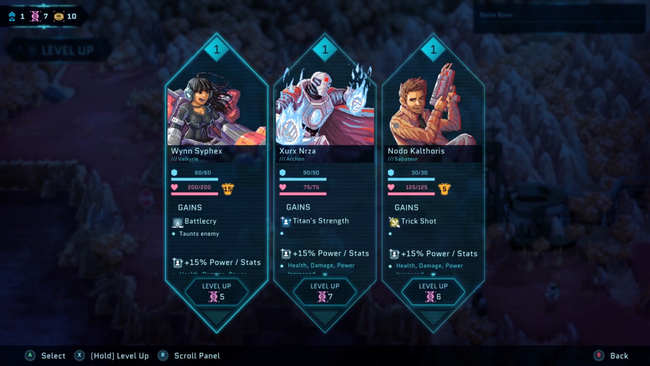
Star Renegades Review
When I first caught gameplay footage of Star Renegades, I was immediately interested in what I saw. A pixel-art turn-based RPG with a colorful palette and a grungy synth-style soundtrack, it somehow reminded me of games I played in the DOS era, only with some modern tweaks and effects, of course.
The game opens with an anime-style animation that briefly shows how a young girl flees her home - which has fallen under attack by invaders known as the Imperium - and how she grows up to be a soldier fighting against this destructive force. These invaders aren't just trying to take over the galaxy; they are trying to take over all galaxies, meaning every alternate reality is in their sights.

Despite this first opening impression, however, Star Renegades is not very story-driven or character-driven at all. Instead, it much more strongly centers on the game's combat and roguelike mechanics. If you don't care for intricate battle systems or roguelike gameplay loops, then chances are Star Renegades will not be your cup of tea -- this is not a game you play primarily hoping for a grand narrative adventure. There is some dialogue and base characterization between the characters at times throughout the game, but most of it are throwaway jokey quips that don't really land.
It's an endless war against the Imperium set in an endless number of galaxies, and your roguelike runs will effectively take you from fighting the Imperium in one galaxy after the other.
Star Renegades is quite mechanically dense, and it has a bit of a learning curve before the player really understands what exactly they are doing. Bluntly, there are a lot of numbers and currencies and stats and resources and other components to keep track of. For me to detail all the systems in play would be an exercise in tedium, as there's just so much going on that's difficult to state in text. I touched upon a lot of this in my preview last month, but I'll restate a bit of it here.
The basic set up is this: you pick three units to dispatch from your home base to fight against the Imperium. Each unit you can select is unique with their own moveset. For example, the Saboteur specializes in delay skills that can prevent enemies from attacking. The Valkyrie is a frontline fighter that can rally the team and dish out decent damage on her own. The Enforcer is basically pure damage and fairly hearty, though slow.
You can unlock more units to choose from as you play through the game, as well as 'variants' of existing units that tweak their skill set slightly. There are several different characters to choose from, so your battle style and composition can change quite drastically from run to run, depending on who you decide to sortie with.

From here, your team of three is placed on a map with a goal to take out as many Imperium soldiers as you can. These maps are semi-random and broken into sections. While the basic structure of the planet is the same from run to run, the positioning of enemies, amount & type of loot, and other items will change. You only have a limited number of actions on this map before you must take on the planet's boss, known as a Behemoth. You have to observe the layout of the map, see where randomized item caches, health stations, credits, and other components have spawned, and plan your limited actions accordingly.
Many sections of the map will initiate combat with your team. Like the rest of the game, there's a lot to take in here. The primary system in play is the timeline at the top, which indicates when units will attack. This is crucially important, as attacking the enemy before they can attack you will lead to critical hits. You have to manage each character's shield, armor, health, timeline positioning, as well as status effects, buffs, and the fury gauge. Different types of attacks (light, normal, heavy, etc) are also in play, and can be more or less effective against certain types of enemies.
There are other sub-systems in place, such as a card trading, relationship building, and Mordor series-like Nemesis-style systems. Trust me when I say it does all make sense and come together pretty well, just detailing it all in a review doesn't really do it any favors. It's best to just play the game itself to understand how everything all fits into place. Eventually you'll learn the best way to handle the cards, build your relationships, and manage your stat bonuses to get through combat as unscathed as possible.

After spending some time getting used to the admittedly overwhelming user interface, Star Renegade's combat is pretty engaging. It's what you'll be doing about 90% of the time, so it's good that a robust and interesting system was put into place here. Crits, statuses, buffs, attack timing, all of these components have to be considered thoughtfully as you decide each character's action each round. Basic strategies like attacking and healing won't last you too long on their own; you'll have to carefully choose when to attack, defend, buff, delay, and avoid damage as much as possible.
As for the roguelike loop, you'll gain both Intel and Imperium Credits as you defeat enemies. These resources are permanent, and they can be used to unlock new characters, weapons, and other bonuses for your runs. This is in effect the 'permanent' progression that you carry through, which can make subsequent runs a tad easier than your initial rebellion against the Imperium.
The visual and soundtrack presentation for Star Renegades cannot be overstated. It's one of the coolest looking pixel-based games I've experienced. It's a great example of using pixel-art not aiming for a retro SNES-era nostalgia tone, but rather a modern interpretation of what can be done with this sort of art style. The soundtrack is robotic and synth-ey, which matches the artstyle and tone of the game. If anything else, Star Renegade is an audiovisual treat.
The one thing I'm most disappointed in is the amount of content in Star Renegades when it comes to permanent upgrades. There are several characters to unlock (for a total of 13 plus variants), which are easily the most interesting elements in that they can change up the way you approach battle. But otherwise, I feel like the variety from run to run is just a little bit lacking.
The progression mostly unlocks different stat-configurations for weapons & armor that you *can* get by random chance. But that ultimately doesn't affect how each run is actually performed, and it mostly just adds to the pool of possible equipment that *can* appear. Luckily though, the development team has stated plans to continually update the game with new heroes, planets, and bosses, which will make revisiting the game in the future worthwhile.
Star Renegades offers a great artstyle and robust combat system for fans of turn-based RPGs and roguelikes. It doesn't have much to tell in terms of an outward storyline, and some of the roguelike elements feel a little thin, but it's a solid experience if you know what you are getting into.